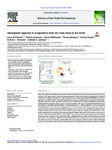Microplastic ingestion in zooplankton from the Fram Strait in the Arctic
| dc.contributor.author | Botterell, ZLR | |
| dc.contributor.author | Bergmann, M | |
| dc.contributor.author | Hildebrandt, N | |
| dc.contributor.author | Krumpen, T | |
| dc.contributor.author | Steinke, M | |
| dc.contributor.author | Thompson, Richard | |
| dc.contributor.author | Lindeque, PK | |
| dc.date.accessioned | 2022-04-29T12:32:25Z | |
| dc.date.issued | 2022-07-20 | |
| dc.identifier.issn | 0048-9697 | |
| dc.identifier.issn | 1879-1026 | |
| dc.identifier.other | 154886 | |
| dc.identifier.uri | http://hdl.handle.net/10026.1/19128 | |
| dc.description.abstract |
Some of the highest microplastic concentrations in marine environments have been reported from the Fram Strait in the Arctic. This region supports a diverse ecosystem dependent on high concentrations of zooplankton at the base of the food web. Zooplankton samples were collected during research cruises using Bongo and MOCNESS nets in the boreal summers of 2018 and 2019. Using FTIR scanning spectroscopy in combination with an automated polymer identification approach, we show that all five species of Arctic zooplankton investigated had ingested microplastics. Amphipod species, found in surface waters or closely associated with sea ice, had ingested significantly more microplastic per individual (Themisto libellula: 1.8, Themisto abyssorrum: 1, Apherusa glacialis: 1) than copepod species (Calanus hyperboreus: 0.21, Calanus glacialis/finmarchicus: 0.01). The majority of microplastics ingested were below 50 μm in size, all were fragments and several different polymer types were present. We quantified microplastics in water samples collected at six of the same stations as the Calanus using an underway sampling system (inlet at 6.5 m water depth). Fragments of several polymer types and anthropogenic cellulosic fibres were present, with an average concentration of 7 microplastic particles (MP) L-1 (0-18.5 MP L-1). In comparison to the water samples, those microplastics found ingested by zooplankton were significantly smaller, highlighting that the smaller-sized microplastics were being selected for by the zooplankton. High levels of microplastic ingestion in zooplankton have been associated with negative effects on growth, development, and fecundity. As Arctic zooplankton only have a short window of biological productivity, any negative effect could have broad consequences. As global plastic consumption continues to increase and climate change continues to reduce sea ice cover, releasing ice-bound microplastics and leaving ice free areas open to exploitation, the Arctic could be exposed to further plastic pollution which could place additional strain on this fragile ecosystem. | |
| dc.format.extent | 154886-154886 | |
| dc.format.medium | Print-Electronic | |
| dc.language | en | |
| dc.language.iso | eng | |
| dc.publisher | Elsevier | |
| dc.subject | Amphipod | |
| dc.subject | Bioavailability | |
| dc.subject | Copepod | |
| dc.subject | Marine litter | |
| dc.subject | Microplastic ingestion | |
| dc.subject | Plastic pollution | |
| dc.title | Microplastic ingestion in zooplankton from the Fram Strait in the Arctic | |
| dc.type | journal-article | |
| dc.type | Journal Article | |
| plymouth.author-url | https://www.webofscience.com/api/gateway?GWVersion=2&SrcApp=PARTNER_APP&SrcAuth=LinksAMR&KeyUT=WOS:000793322700006&DestLinkType=FullRecord&DestApp=ALL_WOS&UsrCustomerID=11bb513d99f797142bcfeffcc58ea008 | |
| plymouth.volume | 831 | |
| plymouth.publication-status | Published | |
| plymouth.journal | Science of the Total Environment | |
| dc.identifier.doi | 10.1016/j.scitotenv.2022.154886 | |
| plymouth.organisational-group | /Plymouth | |
| plymouth.organisational-group | /Plymouth/Faculty of Science and Engineering | |
| plymouth.organisational-group | /Plymouth/Faculty of Science and Engineering/School of Biological and Marine Sciences | |
| plymouth.organisational-group | /Plymouth/REF 2021 Researchers by UoA | |
| plymouth.organisational-group | /Plymouth/REF 2021 Researchers by UoA/UoA07 Earth Systems and Environmental Sciences | |
| plymouth.organisational-group | /Plymouth/Research Groups | |
| plymouth.organisational-group | /Plymouth/Research Groups/Marine Institute | |
| plymouth.organisational-group | /Plymouth/Users by role | |
| plymouth.organisational-group | /Plymouth/Users by role/Academics | |
| plymouth.organisational-group | /Plymouth/Users by role/Researchers in ResearchFish submission | |
| dc.publisher.place | Netherlands | |
| dcterms.dateAccepted | 2022-03-24 | |
| dc.rights.embargodate | 2022-4-30 | |
| dc.identifier.eissn | 1879-1026 | |
| dc.rights.embargoperiod | Not known | |
| rioxxterms.versionofrecord | 10.1016/j.scitotenv.2022.154886 | |
| rioxxterms.licenseref.uri | http://www.rioxx.net/licenses/all-rights-reserved | |
| rioxxterms.licenseref.startdate | 2022-03-29 | |
| rioxxterms.type | Journal Article/Review |


